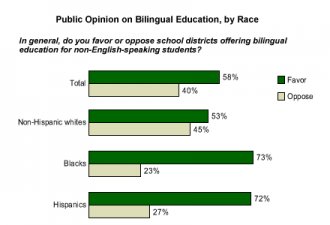
 At 38.8 million nationwide, Hispanics now make up the largest minority group in the United States, according to U.S. Census statistics released last month. Hispanic immigrants, together with immigrants from all over the world, are pouring into the country in record numbers, and many of them speak little or no English upon arrival. The Census estimates that 18% of U.S. residents usually speak a language other than English at home, and 8% speak English less than "very well."
At 38.8 million nationwide, Hispanics now make up the largest minority group in the United States, according to U.S. Census statistics released last month. Hispanic immigrants, together with immigrants from all over the world, are pouring into the country in record numbers, and many of them speak little or no English upon arrival. The Census estimates that 18% of U.S. residents usually speak a language other than English at home, and 8% speak English less than "very well."
The announcement that Hispanics now outnumber all other American minorities has consequences for the education community: specifically, what is the best way to educate U.S. students who are not English-proficient?
Bilingual education - in which non-English-speaking students are taught intensive English language courses together with other subjects (such as math, science, and history) in their native languages - is a strategy advocated by many education experts and offered in school districts across the country. When asked about bilingual education in Gallup's June 2003 survey on minority rights and relations*, a majority of Americans expressed favorable attitudes toward it: 58% favor "school districts offering bilingual education for non-English-speaking students, " and 40% oppose it.
What's the Best Way to Teach English?
But not everyone agrees that bilingual education is the most beneficial strategy for kids who don't speak English. Opponents feel that "English immersion" is the best way to educate students who are not English-proficient, maintaining that students learn English most quickly when they attend classes taught only in English, with English-speaking peers. California, which has one of the highest percentages of immigrant students, switched its schools from bilingual education to English immersion in 1998.
Supporters of bilingual education, including many minority and Hispanic rights advocates, argue that English-only instruction causes non-English-speaking students to lag behind academically, especially in other subject areas that are neglected while students concentrate on learning English.
MORE TRANSLATION VIDEO












